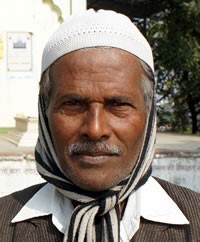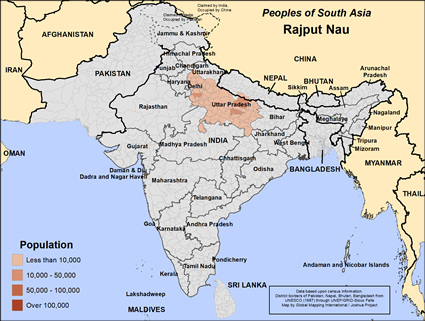Starting in the 5th century, there was a massive attack by the White Huns in what is now northern and northwestern India and Pakistan. About a century later the reigning Hindu-based Gupta Empire broke up, leaving the Subcontinent vulnerable to Muslim invaders from the north. As time went on, invaders took over land and integrated with the settled peoples of this region. Tribal leaders, especially those involved with defense, were accepted as Kshatriya, the second highest varna (major type of castes) in Hindu society, while their followers became the fourth and lowest varna. Priests became the Brahmins, the highest of the four varnas.
The Rajputs, who were part of the Kshatriya varna, became politically important in the seventh century. From around 800CE Rajput dynasties ruled northern India. Petty Rajput kingdoms were the main obstacle for Muslim domination of the Hindu subcontinent. For more than 500 years Rajputs were the warriors who defended kingdoms from invaders and conquered others. When possible, Rajputs settled down, became nobles, and enjoyed the lives of landed gentry.
Over a period of a couple hundred years, invaders penetrated the Rajput wall that protected the Subcontinent. Some Rajput subgroups converted to Islam during this time. The British Raj took over the Islamic Moghul Empire in South Asia. During their rule, which ended in 1947, the British recruited Rajputs into their military units. By the 1930s the Indian census did not note that someone is Rajput, so Rajput lineage has been less clear ever since.
In the early 1970s, Indian Prime Minister Indira Gandhi abolished Rajput titles and property rights. Rajputs have kept alive their proud history of conquest, bravery and military might.
Nau Rajputs are concentrated in Uttar Pradesh, though there are Rajputs all over the country.
Though Nau Rajputs are still in the armed forces or own land, many have moved on to other livelihoods. Wealthy Rajputs now own impressive hotels in Rajasthan where tourists can be introduced to their history and culture. Rajputs who aren't so fortunate work as small businessmen or wage laborers.
Nau Rajputs are Sunni Muslims. Like most Sunni Muslims in South Asia, they believe the basic tenets of Islam, but they have some holdover beliefs from when their ancestors were Hindus.
Nau Rajputs are going through an identity crisis. They can no longer depend on land ownership or military careers, especially with the Indian government reserving prestigious jobs for "backward" (i.e., underprivileged) castes. Believers with the right skills can help them during this time of transition.
Pray for the Muslim Nau Rajput community to increasingly grow in awareness of Jesus, his life and his sacrifice for them.
Pray the Lord will give Nau Rajputs a spiritual hunger, then satisfy that hunger.
Pray that Nau Rajputs will understand the value of becoming part of God's royal family.
Pray for a Holy Spirit led humility for all Rajput communities to fall at the feet of the King of kings.
Pray for a movement to Christ among every Rajput community.
Scripture Prayers for the Rajput Nau in India.
http://induhistory.blogspot.com/p/rajput-history.html
https://www.britannica.com/topic/Rajput
https://en.wikipedia.org/wiki/Rajput
| Profile Source: Joshua Project |











